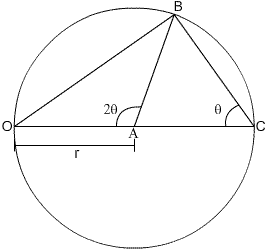Ewald sphere
Consider a circle of radius r, with points B and C lying on the circumference.

By using simple trigonometry,
\[\sin \theta = \frac{OB}{{2r}}\]
If this geometry is constructed in reciprocal space, then it has some important implications.
The radius can be set to 1/λ, where λ is the experimental wavelength.
If O is the (0 0 0) reciprocal lattice point, and B is a general point (h k l), then the distance OB is 1/dhkl = Shkl The reciprocal vector between the points, S, increases in magnitude with increasing 2θ,
Hence
\(\sin \theta \) = \(\frac{{\frac{1}{{{d_{hkl}}}}}}{{\frac{2}{\lambda }}}\)
i.e.
λ = 2 dhkl sin θ
The Ewald circle represents in reciprocal space all the possible points where planes (reflections) could satisfy the Bragg equation.
In 3-dimensions an Ewald Sphere represents all the possibilities. For simplicity, it is often drawn as a circle in two dimensions.
The animation below shows how the Ewald circle is used in diffraction to determine the angles at which the Bragg equation is satisfied.
Now that you have seen the construction of the Ewald Sphere try finding some points yourself in this simulation:
In order to ‘measure’ a diffraction spot one has to position the detector (film or electronic) on the reciprocal lattice point.

